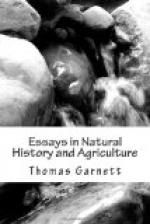When they begin to hatch, open a communication between the boxes and the little reservoir below, and if this communicates with a watercourse in which aquatic plants are growing, so much the better. The fry, as soon as they are strong enough, will make their way into this ditch, and will find abundance of food among the water plants; thence they ought to be able to make their way into the brook, river, or lake which it is intended to store with them. All ducks, wild and tame, should be driven from this ditch, or few of the Trout will be allowed to find their way to their final place of destination.
These rules, with some modification, are applicable to the breeding of Salmon as well as Trout; the only difference being in the mode of placing the female fish, when obtaining the roe, and the size of the gravel in which the spawn is deposited in the boxes. The Salmon is too large a fish to put into the vessels in which the diluted milt is placed, but I think that she should be held by an assistant, in such a manner that the tail and lower part of the body up to the vent are immersed in the water containing the milt. And it is also very necessary to hold her firmly, otherwise a large fish, in the struggles which it makes to get free, is apt to upset the vessel containing the milt, and then the experiment is at an end, at least for the time. Being held firmly by the assistant, as above stated, the belly of the fish must be gently pressed by the hands to promote the exclusion of the spawn, which on exclusion must be gently stirred in the diluted milt, to bring every grain into contact with it; but the roe ought not to remain in contact with the milt a minute, if it can sooner be got out, as I have found that if the diluted milt be too strong, or if the ova remain too long in contact with it, they become opaque, and never hatch at all, apparently because they are over-impregnated. In the ordinary way in which Salmon and Trout are bred, the milt must be largely diluted with water, and the contact between the milt and ova can only be momentary, for the streams in which these fish spawn (particularly the Salmon) are so rapid, that the milt on exclusion must be carried away immediately.
There is another method, which is preferred by Ramsbottom, to the one I have been describing, and it is certainly less troublesome. This is to take the ova from the female fish in the first place (taking care to exclude the air from it, by immersing the fish into water up to the vent), and when all the roe has been collected into a large bowl or basin, then mix the milt with it, the same diluted in the proportion which has been before described, namely, until the water which covers the roe becomes lightly opalescent.




